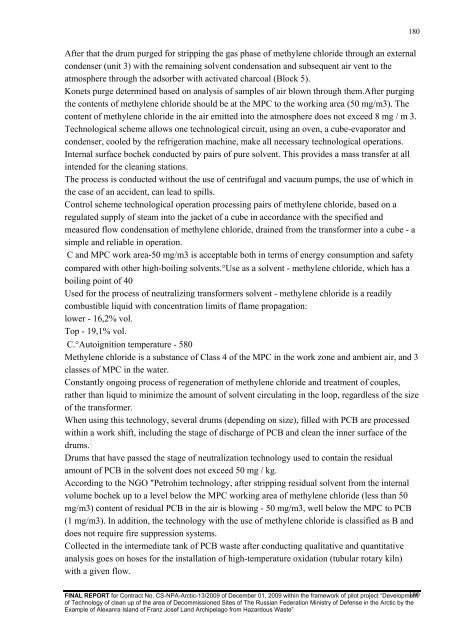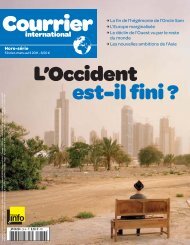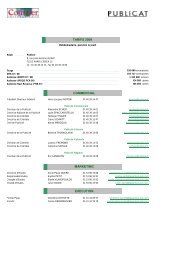2 ОРГАНИЗАЦИЯ И МЕТОДИКА РАБОТ - Courrier international
2 ОРГАНИЗАЦИЯ И МЕТОДИКА РАБОТ - Courrier international
2 ОРГАНИЗАЦИЯ И МЕТОДИКА РАБОТ - Courrier international
You also want an ePaper? Increase the reach of your titles
YUMPU automatically turns print PDFs into web optimized ePapers that Google loves.
After that the drum purged for stripping the gas phase of methylene chloride through an external<br />
condenser (unit 3) with the remaining solvent condensation and subsequent air vent to the<br />
atmosphere through the adsorber with activated charcoal (Block 5).<br />
Konets purge determined based on analysis of samples of air blown through them.After purging<br />
the contents of methylene chloride should be at the MPC to the working area (50 mg/m3). The<br />
content of methylene chloride in the air emitted into the atmosphere does not exceed 8 mg / m 3.<br />
Technological scheme allows one technological circuit, using an oven, a cube-evaporator and<br />
condenser, cooled by the refrigeration machine, make all necessary technological operations.<br />
Internal surface bochek conducted by pairs of pure solvent. This provides a mass transfer at all<br />
intended for the cleaning stations.<br />
The process is conducted without the use of centrifugal and vacuum pumps, the use of which in<br />
the case of an accident, can lead to spills.<br />
Control scheme technological operation processing pairs of methylene chloride, based on a<br />
regulated supply of steam into the jacket of a cube in accordance with the specified and<br />
measured flow condensation of methylene chloride, drained from the transformer into a cube - a<br />
simple and reliable in operation.<br />
C and MPC work area-50 mg/m3 is acceptable both in terms of energy consumption and safety<br />
compared with other high-boiling solvents.Use as a solvent - methylene chloride, which has a<br />
boiling point of 40<br />
Used for the process of neutralizing transformers solvent - methylene chloride is a readily<br />
combustible liquid with concentration limits of flame propagation:<br />
lower - 16,2% vol.<br />
Top - 19,1% vol.<br />
C.Autoignition temperature - 580<br />
Methylene chloride is a substance of Class 4 of the MPC in the work zone and ambient air, and 3<br />
classes of MPC in the water.<br />
Constantly ongoing process of regeneration of methylene chloride and treatment of couples,<br />
rather than liquid to minimize the amount of solvent circulating in the loop, regardless of the size<br />
of the transformer.<br />
When using this technology, several drums (depending on size), filled with PCB are processed<br />
within a work shift, including the stage of discharge of PCB and clean the inner surface of the<br />
drums.<br />
Drums that have passed the stage of neutralization technology used to contain the residual<br />
amount of PCB in the solvent does not exceed 50 mg / kg.<br />
According to the NGO "Petrohim technology, after stripping residual solvent from the internal<br />
volume bochek up to a level below the MPC working area of methylene chloride (less than 50<br />
mg/m3) content of residual PCB in the air is blowing - 50 mg/m3, well below the MPC to PCB<br />
(1 mg/m3). In addition, the technology with the use of methylene chloride is classified as B and<br />
does not require fire suppression systems.<br />
Collected in the intermediate tank of PCB waste after conducting qualitative and quantitative<br />
analysis goes on hoses for the installation of high-temperature oxidation (tubular rotary kiln)<br />
with a given flow.<br />
FINAL REPORT for Contract No. CS-NPA-Arctic-13/2009 of December 01, 2009 within the framework of pilot project Development<br />
of Technology of clean up of the area of Decommissioned Sites of The Russian Federation Ministry of Defense in the Arctic by the<br />
Example of Alexanra Island of Franz Josef Land Archipelago from Hazardous Waste<br />
180<br />
180








